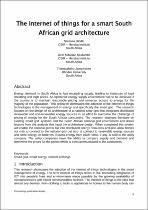JavaScript is disabled for your browser. Some features of this site may not work without it.
- ResearchSpace
- →
- Research Publications/Outputs
- →
- Conference Publications
- →
- View Item
| dc.contributor.author |
Dlodlo, N

|
|
| dc.contributor.author |
Mudumbe, JM

|
|
| dc.contributor.author |
Ndwe, T

|
|
| dc.date.accessioned | 2015-03-12T09:52:10Z | |
| dc.date.available | 2015-03-12T09:52:10Z | |
| dc.date.issued | 2014-11 | |
| dc.identifier.citation | Dlodlo, N, Mudumbe, J.M and Ndwe, T.L. 2014. The internet of things for smart South African grid architecture. IDIA, Port Elizabeth, South Africa, 3-4 November 2014 | en_US |
| dc.identifier.uri | http://hdl.handle.net/10204/7914 | |
| dc.description | International Development Informatics Association, Port Elizabeth, South Africa, 3-4 November 2014 | en_US |
| dc.description.abstract | Energy demand in South Africa is fast exceeding supply, leading to instances of load shedding and high prices. An optimized energy supply environment has to be achieved if the country is to maintain reasonable pricing and universal access to energy for the majority of the population. This research showcases the adoption of the internet of things technologies in the management of energy and specifically the smart grid. The research focuses on the design of architecture of a national smart grid that integrates distributed renewable and non-renewable energy sources in an effort to overcome the challenge of pricing of energy for the South African consumers. The research analyses literature on existing smart grid systems and the South African national grid environment and draws lessons from the analysis that input the architecture design. When completed this system will enable the national grid to tap into distributed energy resources and also allow homes not only to connect to the national grid but also to connect to renewable energy sources and store energy on batteries. Excess energy from each home, if any, is sold to the utility company. The utility companies have the ability to compare supply and demand and determine the prices for the period which is then communicated to the consumers. | en_US |
| dc.language.iso | en | en_US |
| dc.publisher | International Development Informatics Association. 2014 | en_US |
| dc.relation.ispartofseries | Workflow;13842 | |
| dc.subject | Smart grid | en_US |
| dc.subject | Smart energy | en_US |
| dc.subject | Internet of things | en_US |
| dc.title | The internet of things for a smart South African grid architecture | en_US |
| dc.type | Conference Presentation | en_US |
| dc.identifier.apacitation | Dlodlo, N., Mudumbe, J., & Ndwe, T. (2014). The internet of things for a smart South African grid architecture. International Development Informatics Association. 2014. http://hdl.handle.net/10204/7914 | en_ZA |
| dc.identifier.chicagocitation | Dlodlo, N, JM Mudumbe, and T Ndwe. "The internet of things for a smart South African grid architecture." (2014): http://hdl.handle.net/10204/7914 | en_ZA |
| dc.identifier.vancouvercitation | Dlodlo N, Mudumbe J, Ndwe T, The internet of things for a smart South African grid architecture; International Development Informatics Association. 2014; 2014. http://hdl.handle.net/10204/7914 . | en_ZA |
| dc.identifier.ris | TY - Conference Presentation AU - Dlodlo, N AU - Mudumbe, JM AU - Ndwe, T AB - Energy demand in South Africa is fast exceeding supply, leading to instances of load shedding and high prices. An optimized energy supply environment has to be achieved if the country is to maintain reasonable pricing and universal access to energy for the majority of the population. This research showcases the adoption of the internet of things technologies in the management of energy and specifically the smart grid. The research focuses on the design of architecture of a national smart grid that integrates distributed renewable and non-renewable energy sources in an effort to overcome the challenge of pricing of energy for the South African consumers. The research analyses literature on existing smart grid systems and the South African national grid environment and draws lessons from the analysis that input the architecture design. When completed this system will enable the national grid to tap into distributed energy resources and also allow homes not only to connect to the national grid but also to connect to renewable energy sources and store energy on batteries. Excess energy from each home, if any, is sold to the utility company. The utility companies have the ability to compare supply and demand and determine the prices for the period which is then communicated to the consumers. DA - 2014-11 DB - ResearchSpace DP - CSIR KW - Smart grid KW - Smart energy KW - Internet of things LK - https://researchspace.csir.co.za PY - 2014 T1 - The internet of things for a smart South African grid architecture TI - The internet of things for a smart South African grid architecture UR - http://hdl.handle.net/10204/7914 ER - | en_ZA |






